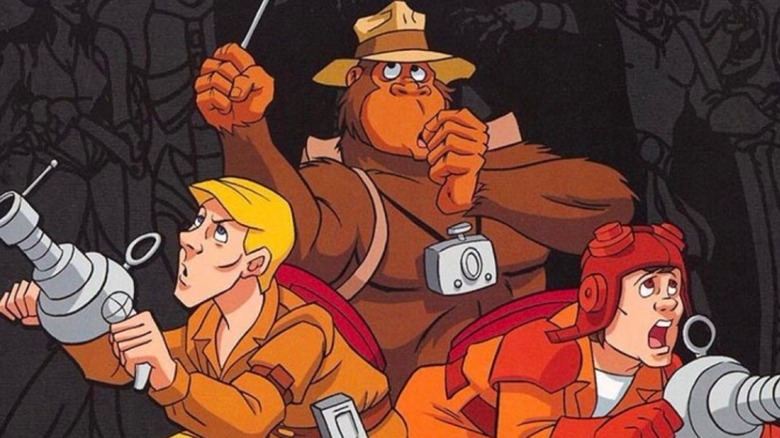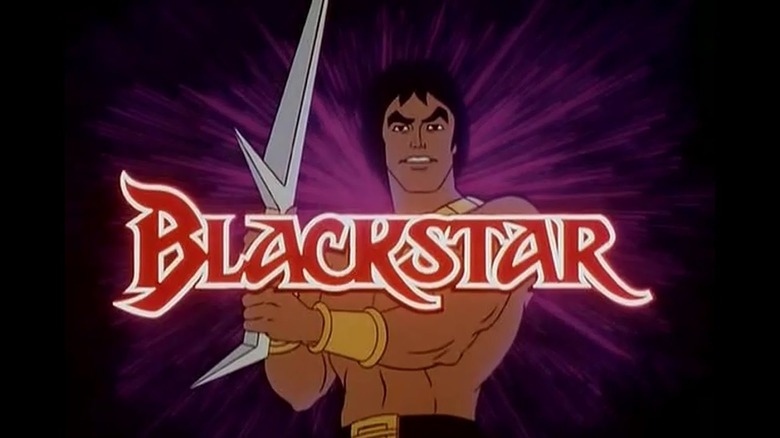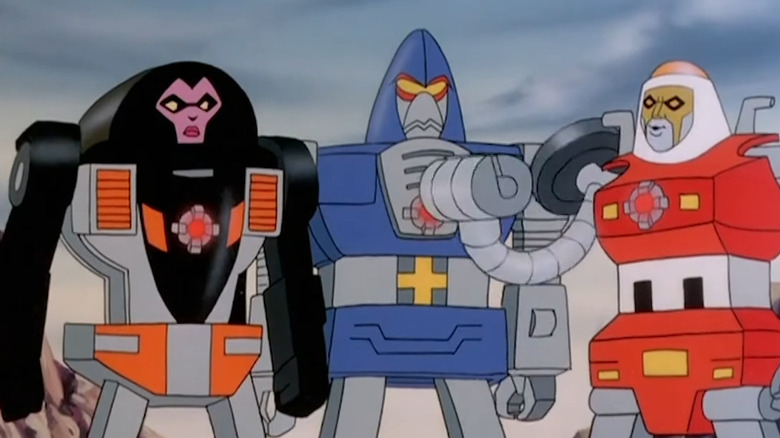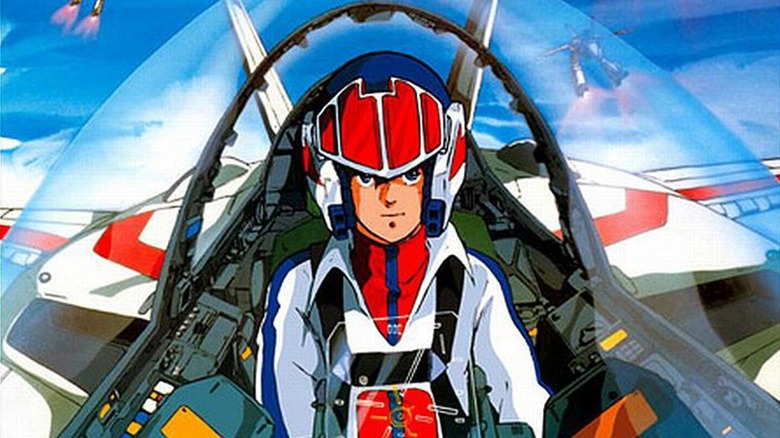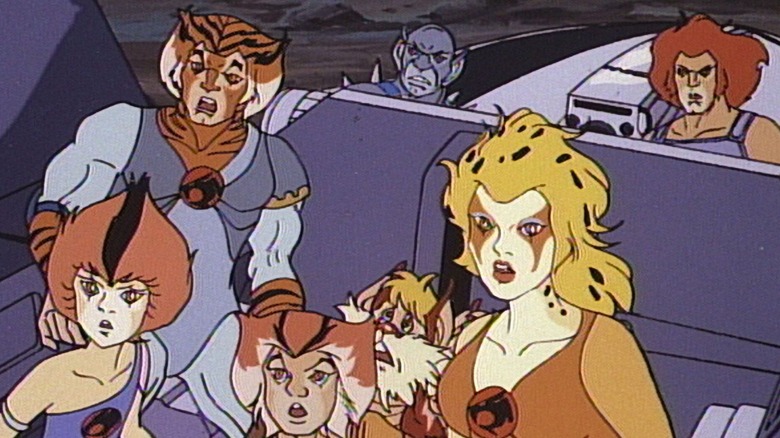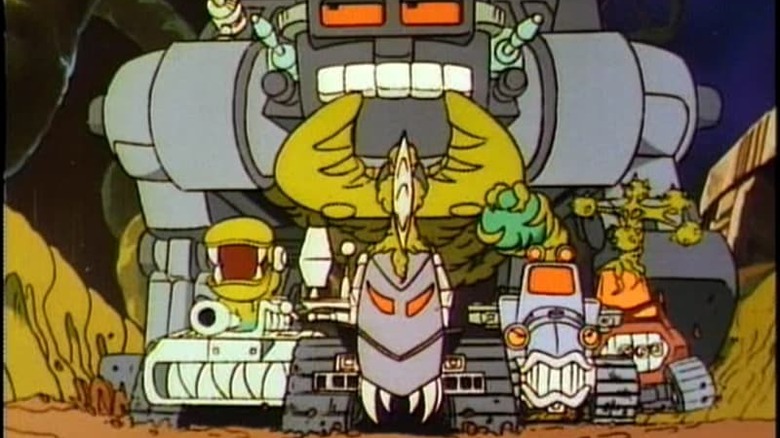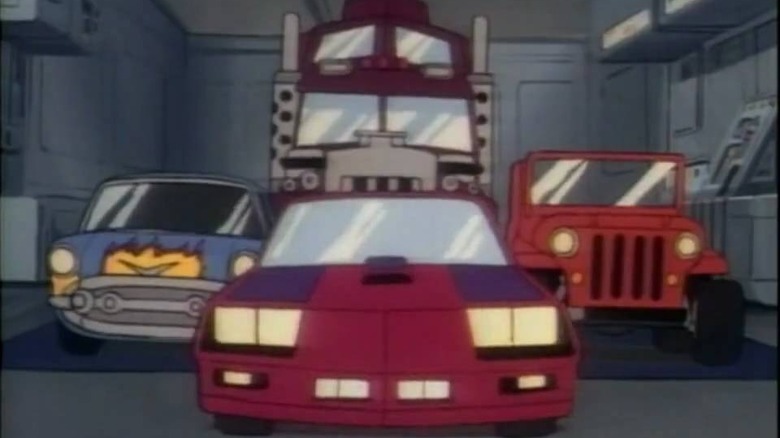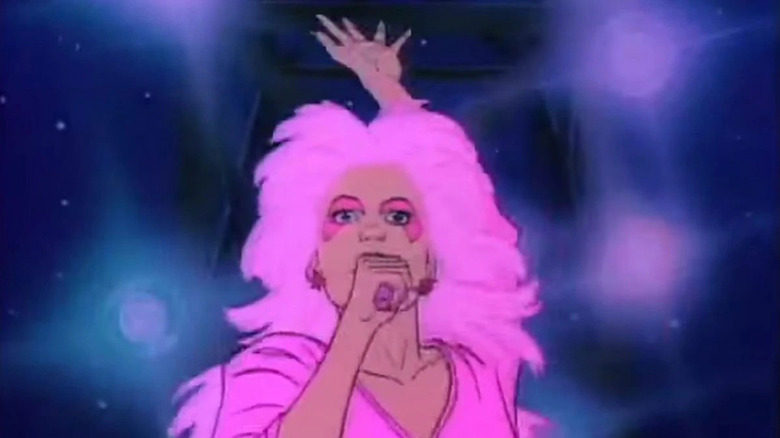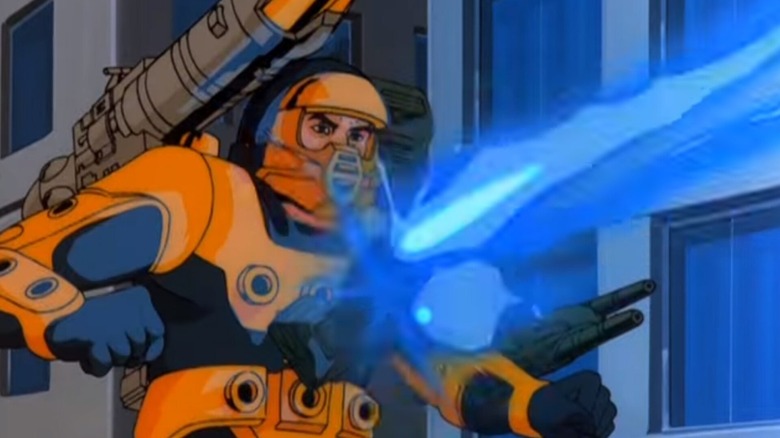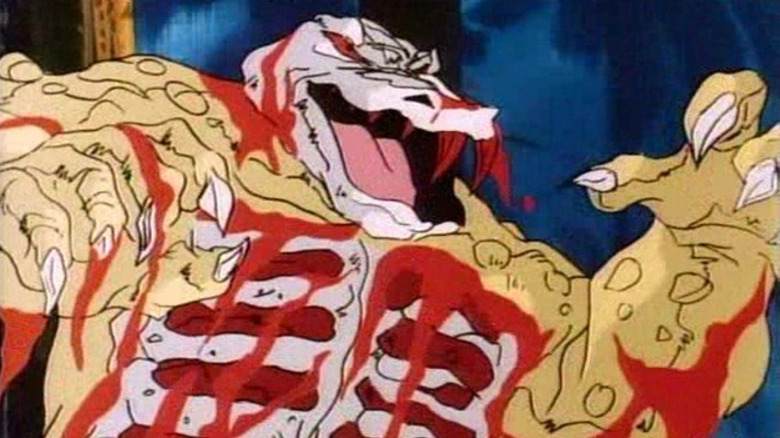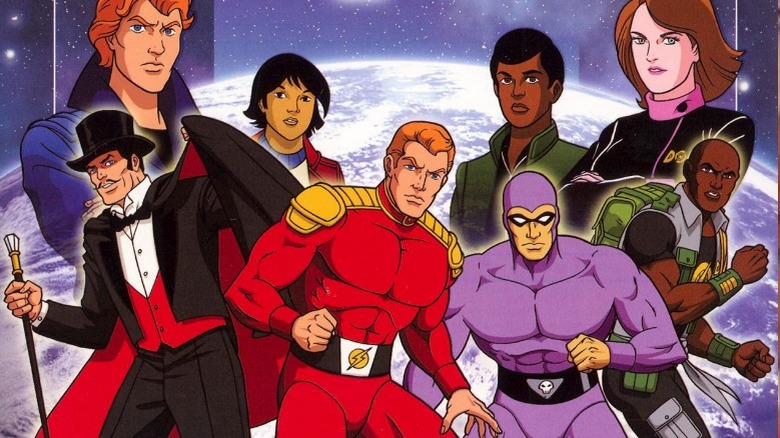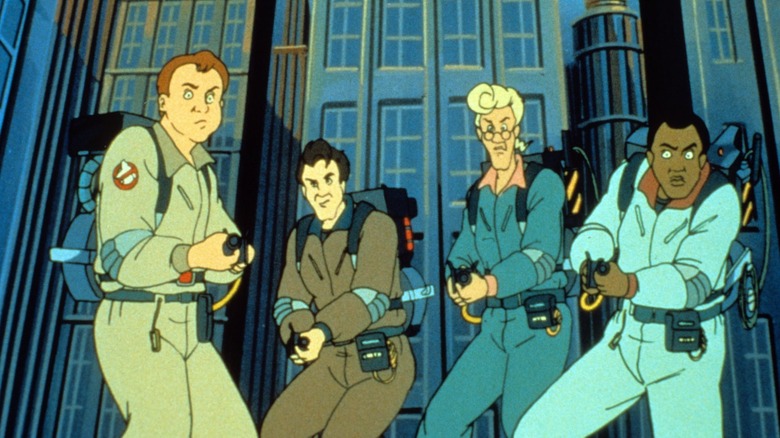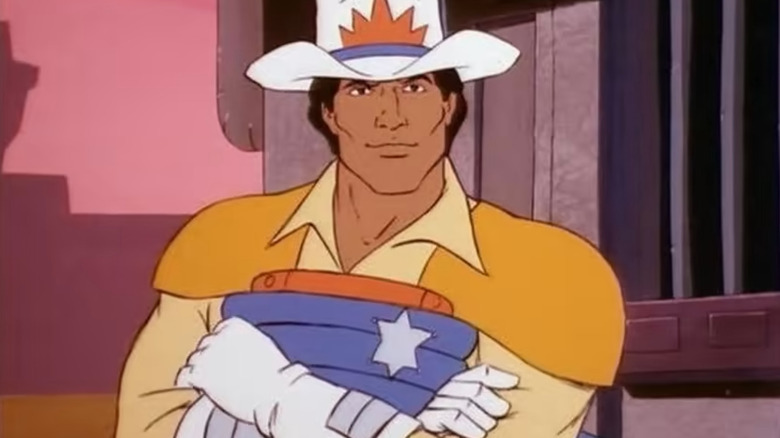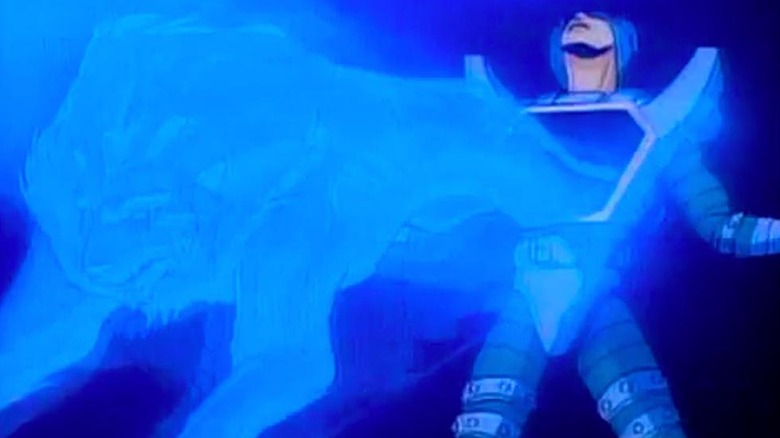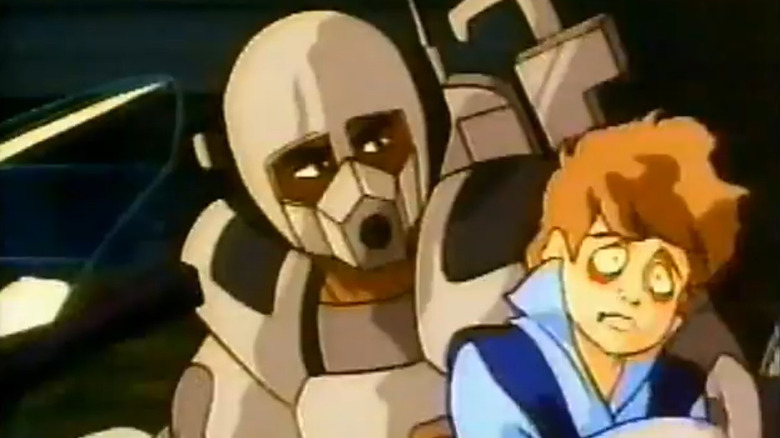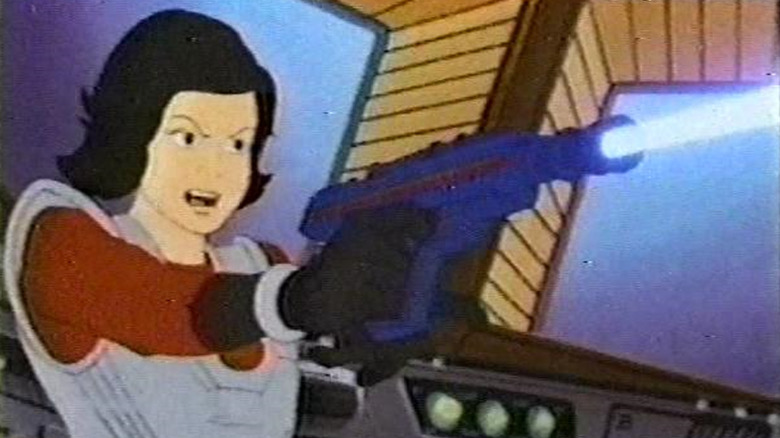Overlooked '80s Cartoon-Toy Franchises Ripe For Revival
Between the Marvel Cinematic Universe, Star Wars, and even non-Disney-owned name brands like Star Trek and Fast & Furious, it helps a film or TV series' odds to be part of a franchise that already has a certain amount of audience buy-in. This principle extends to properties that made their debut as cartoon shows with attendant toy lines during the 1980s.
G.I. Joe has racked up three live-action films since 2009, including "Snake Eyes" in 2021, while the Transformers have churned out six CGI-heavy live-action films since 2007, with a seventh set for a 2022 release. Netflix produced eight seasons of Voltron from 2016-18, five seasons of She-Ra from 2018-20, and two entirely different takes on He-Man and the Masters of the Universe in 2021.
But when it comes to cartoon-toy franchises that are ripe for multimedia revivals, the '80s has a lot more than those four properties. Here are a few that we think are due for a comeback.
Blackstar
Before "He-Man and the Masters of the Universe" premiered in 1983, Filmation did what could be considered a dry-run of the concept with "Blackstar" in 1981. Native American astronaut John Blackstar's spaceship was swept into a black hole to strand him in an "ancient alien" universe, where he became a bare-chested, sword-wielding defender of the Dungeons & Dragons-style inhabitants of the planet Sagar.
Netflix's "Masters of the Universe: Revelation" has already incorporated a number of Filmation's early and alternate versions of He-Man into canon, including Vikor, Wun-Dar, He-Ro, and King Grayskull. Likewise, in the original series, He-Man's mom was Earth astronaut Marlena Glenn, who crash-landed on the planet Eternia and became its queen after she married King Randor.
The original series episode "Visitors from Earth" showed another Earth spaceship crash-landing on Eternia whose astronauts recognized Marlena, so Blackstar could be tied into the He-Man mythos by revealing that he and Marlena knew each other back on Earth as fellow NASA pilots. Native American heroes remain under-represented in genre fiction, so that's another plus.
GoBots
Back in the '80s, if you got GoBots instead of Transformers for your birthday or Christmas, that was your parents' way of saying neither of them wanted custody of you in the divorce. "Challenge of the GoBots" premiered on TV screens a little more than a week before "The Transformers" in 1984, but both the GoBots cartoon and toys were immediately recognized by '80s kids as inferior versions of the Transformers ... except for one unintended quirk.
A side-effect of almost all the Gobots being so cheaply made was that most of them, in their transformed robot forms, stood roughly around the same 3.75-inch height that was standard for both G.I. Joe and Star Wars figures. Better yet, characters like Guardian Scooter and Renegade Cy-Kill transformed into vehicle modes that were close to compatible with 3.75-inch human figures as well.
While the cartoon versions of the GoBots towered over humans, just like the Transformers, there's an untapped niche for transforming robots who can interact with humans on an even eye-to-eye level, since even Bumblebee, the Autobot whose relatively small size makes him most relatable to audiences, is still big.
Robotech
When Harmony Gold USA received the license to release the Japanese mecha anime series "Super Dimension Fortress Macross" from 1982-83, "Super Dimension Cavalry Southern Cross" from 1984, and "Genesis Climber MOSPEADA" from 1983-84, none of those three series had enough episodes each to meet the American weekday syndication minimum of 65 episodes.
So, Harmony Gold revised the dialogue and edited the content of the three anime to turn them into a single cartoon series, "Robotech," released in 1985, in which the crash-landing of an alien spaceship in the South Pacific forces three generations of humans to fend off three successive waves of alien invasions by utilizing the technology that humanity reverse-engineered from that spaceship crash.
Robotech introduced an entire generation of '80s kids to generational sagas before the 1987 premiere of "Star Trek: The Next Generation," with as much drama as their parents' live-action soap operas, plus it was as unafraid to kill off its fan-favorite characters as "Game of Thrones." And 2021 saw the previously contested international licensing rights to Robotech finally get settled, so there's no legal reason not to reintroduce this franchise to a new generation.
ThunderCats & SilverHawks
This choice might prove controversial, given that the ThunderCats have received no fewer than three chances to achieve franchise success, with the original series running four seasons from 1985-89, followed by a 2011-12 anime-inspired reboot and the comedic "Teen Titans Go!"-style "ThunderCats Roar" in 2020, both only lasting a single season.
But beyond the "He-Man for furries" nature of the surviving tribe of the doomed planet Thundera, each modeled on a different wild cat, one of the most fascinating aspects of the ThunderCats is how they settled on the planet "Third Earth," which appears to be our own Earth at some nebulous point in the future when most humans have left.
And 1986's "SilverHawks" featured a team of mostly human outer-space cops who volunteered to be turned into birdlike cyborgs, so there's an opportunity to tease a shared-universe connection between the Third Earth humanity largely abandoned and the space-faring humans who became "partly metal, partly real" to take down alien gangsters like Mon*Star (who shared a voice actor and a similar transformation sequence with Mumm-Ra).
We're not bringing back 1987's "TigerSharks," though. That's where I draw the line.
Jayce and the Wheeled Warriors
The "Wheeled Warriors" toy line consisted of two rival fleets of weaponized vehicles, the heroic Lightning League and the evil Monster Minds, with a nifty parts-swapping gimmick common to a number of '80s toys. The 1985-86 "Jayce and the Wheeled Warriors" cartoon was Star Wars with the aesthetics of 1983's "Krull," and grotesquely organic creature designs worthy of David Cronenberg.
Altruistic botanist Audric wanted to eradicate famine by bioengineering plants, but a freak accident mutated those plants into the malevolent Monster Minds, cloned vehicles with organic weapon appendages. Now, Audric's son, Jayce, must try to find his father — with his allies Gillian the wizard, Oon the robotic "Eternal Squire," Flora the human-looking plant girl, and their mercenary spaceship captain, Herc Stormsailor — since Jayce and Audric each possess half of a root that, when reunited, could destroy the Monster Minds.
The toy line fell short because the Lightning League pilots were all generic human figures, since DiC Entertainment and writer J. Michael Straczynski didn't create Jayce and his human allies for the cartoon until after the toys were already produced.
M.A.S.K.
"Mobile Armored Strike Kommand" is a katastrophically ill-konceived backronym, but the concept combines the most toyetic aspects of G.I. Joe and the Transformers with the Fast & Furious films' fetishization of secretly souped-up hot rods.
What appear to be run-of-the-mill street rigs transform into advanced combat vehicles, piloted by members of the M.A.S.K. team or its enemies in V.E.N.O.M. (which stands for "Vicious Evil Network Of Mayhem," to avoid subtlety), all of whom come equipped with visually distinctive helmets that grant them each different deus ex machina superpowers.
The G.I. Joe and Transformers toy lines are owned by Hasbro, while the M.A.S.K. toys were originally produced by Kenner, but Hasbro has since absorbed Kenner, so M.A.S.K. and V.E.N.O.M. could be reintroduced as specialized subdivisions of G.I. Joe and Cobra, respectively, who reverse-engineered Transformer technology so humans could conduct their own campaigns of high-tech covert warfare.
And not to "Jump to Conclusions," but actor Richard Riehle (Tom Smykowski in "Office Space") has remained a fan-casting favorite for the role of V.E.N.O.M. leader Miles Mayhem for years.
Jem and the Holograms
Here's a four-decade secret: Any boy who watched "He-Man and the Masters of the Universe" in the 1980s probably also watched "She-Ra: Princess of Power," and if he watched any other Sunbow cartoons, he likely watched "Jem and the Holograms" sometime during their 1985-88 run, even if he claimed otherwise when chatting with the guys.
Sunbow Productions created the cartoons for Hasbro toy lines like G.I. Joe, the Transformers, the Inhumanoids (more on them shortly) and Jem, and all four shows were implied to exist in the same universe by their shared use of fictional reporter Hector Ramirez, based on real-life reporter Geraldo Rivera.
And yes, Jem belonged in that shared universe, for all the reasons the 2015 "Jem and the Holograms" live-action film failed to capture, because the "Jem" cartoon was a sci-fi superhero soap opera with corporate intrigue. Starlight Music owner Jerrica Benton adopted the superstar songstress identity of Jem with the aid of Synergy, an advanced holographic AI, and fought to protect her father's company from the takeover attempts of music industry executive Eric Raymond, who managed the two rival bands to Jem and the Holograms.
Centurions: Power Xtreme
In the "near future" of the 21st century, mad scientist Doc Terror and his fellow cyborg henchman Hacker try to take over the world with their robot army, but are foiled by the Centurions, which consist of "brilliant sea operations commander" Max Ray, "rugged land operations specialist" Jake Rockwell, and "daring air operations expert" Ace McCloud.
Each Centurion has his own arsenal of weapons and environment-specific equipment that plugs into the ports on his "exo-frame" suit, affording them all swappable parts like the "Wheeled Warriors" toys, and the explicit assignation of land, sea, and air specializations clearly defines each character's distinct role and personality within the team. And since the Centurions' equipment is teleported to them on the scene from an orbiting space station, they can summon any weapon they need, then return it to their "Sky Vault" as soon as they're done using it.
Full journalistic disclosure: The author received a Jake Rockwell action figure as one of his Christmas gifts in 1986, but I nonetheless contend that Dwayne "The Rock" Johnson would be perfectly cast as Jake Rockwell in any of his natural disaster blockbusters.
Inhumanoids
Another one-season wonder from 1986, "Inhumanoids" pitted humanity against a G-rated version of the Cthulhu Mythos, while borrowing even more liberally from Jules Verne's "Journey to the Center of the Earth" than Legendary Entertainment's MonsterVerse film franchise.
A team of government-funded geological scientists called "Earth Corps" don bulky "exosuits" that not only aid them in exploring deep beneath the surface of the Earth, but also protect them in battling against the titanic "Inhumanoids" — lava-vomiting Metlar, self-regenerating and vine-like Tendril, and the undead dinosaur-skulled D'Compose, whose touch can transform humans into gigantic decaying zombies — all of whom have recently escaped ages of subterranean captivity. The cartoon's backstory literally spanned the geologic time scale of the Earth, and its characters ranged from benevolent elemental beings known as "Mutores" to corrupt human industrialists and government officials looking to harness the Inhumanoids' powers for their own selfish gains.
While 1987's "G.I. Joe: The Movie" animated film retconned the terrorist organization Cobra into a secret pre-human civilization's attempt to reclaim the planet, G.I. Joe works best when limited to James Bond-level high-tech sci-fi, leaving tales about ancient elemental forces to franchises like the Inhumanoids.
Defenders of the Earth
Imagine if the last Avengers standing after "Endgame" had been Star-Lord, Black Panther, Doctor Strange, and Iron Man. Wild lineup, right? Well, in 1986, King Features Syndicate didn't need to imagine, because the comic strips under its umbrella still included Flash Gordon, the Phantom, and Mandrake the Magician, with the latter comic strip also including Mandrake's partner, the mechanically savvy strongman and strategist Lothar.
After the "Super Friends" animated series ran from 1973-86, spawning the "Super Powers Collection" of action figures in 1984, King Features Syndicate finally realized it had its own in-house Justice League. So, Flash Gordon, the Phantom, Mandrake, and Lothar were rounded up and each given their own teenage son or daughter to form the 1986-87 "Defenders of the Earth" cartoon and toy line.
The cartoon made the missteps of fridging Dale Arden and switching kids between Flash Gordon and the Phantom, so that Flash, the team's alpha-male leader, would have a son instead of a daughter, while the toy line neglected to release any action figures of the kids, who were created to serve as these decades-old characters' outreach to "the next generation."
Ghostbusters (Real & Filmation)
If "Ghostbusters: Afterlife" succeeds, we could potentially witness a pent-up demand for further onscreen ghostbusting. There was actually more than one team of cartoon Ghostbusters in the 1980s. Filmation debuted "The Ghost Busters" as a live-action children's sitcom all the way back in 1975. Columbia Pictures received permission from Filmation to use the name "Ghostbusters" for the 1984 film, but Filmation retained its own rights to the title, too, and launched a competing animated series in 1986.
Filmation's "Ghostbusters" beat "The Real Ghostbusters" to TV screens by five days in September of 1986, with the Filmation series serving as an animated sequel to the 1975 live-action show by having the adult sons of the first "Ghost Busters" take over the family business.
Although "Ghostbusters: Afterlife" is a multigenerational affair, bringing back the surviving 1984 crew while introducing a new generation of kids as Ghostbusters, a new "Real Ghostbusters" would be best suited to chronicling as many of the kid Ghostbusters' adventures in animation as possible before their actors age up. The Marvel Cinematic Universe shows on Disney+ have proven TV output can steer a franchise between films.
Ironically, the multigenerational approach of "Ghostbusters: Afterlife" could get audiences interested in seeing Filmation's "Ghostbusters," which showed fathers and sons working together, and could introduce adult grandkids to carry on a continuation of its franchise.
BraveStarr
Filmation's final animated series was as progressive as ever, this time assigning the Native American Marshal BraveStarr to serve as the lone lawman on the frontier planet of "New Texas," whose mines contained the rare mineral and powerful fuel source known as "Kerium," making it a target for alien and magical outlaws like Tex Hex and his gang in the Wild West-themed future of the 23rd century.
BraveStarr had a wise shaman mentor, a talking bipedal horse sidekick and marksman called "Thirty/Thirty," and a potential love interest in Judge J.B. McBride, the only other representative of law and order on the planet (aside from Deputy Fuzz, the dwarfish comic relief meant to resemble a humanoid prairie dog).
Aside from the welcome step of making the square-jawed, square-dealing, handsome hero protagonist Native American, "BraveStarr" inverted the dynamic of steampunk's anachronisms by having the show's outwardly rustic settings, tools and other trappings revealed to be running on advanced digital technology, as each episode opened with a sequence of an antique paper prospector's map burning away to reveal a printed circuit board beneath.
Visionaries: Knights of the Magical Light
Of all the animated series produced by Sunbow in the 1980s, 1987's "Visionaries: Knights of the Magical Light" shows the most signs of the writers committing to the intricate details of their worldbuilding, as the futuristic world of Prysmos literally enters a new dark age when the alignment of its three suns emits enough radiation to permanently deactivate all electronic technology on the planet.
Prysmos' society reverts to pre-industrial neo-feudalism, but is able to substitute science with sorcery when the morally nebulous wizard Merklynn (no, really) bestows magical powers on two feuding factions of knights known as the Visionaries — the heroic Spectral Knights and evil Darkling Lords — after they prove themselves in a free-for-all contest of skill and character in his labyrinthine mountain lair.
The extremely '80s gimmick of the toy line was that each action figure's armor had a chestplate hologram of their animal totem — the characters transformed into those creatures in the cartoon — while some also wielded magical staffs, bearing additional holograms, which conferred further powers. Surely affordable consumer holograms have advanced enough over four decades to make this concept novel again?
Spiral Zone
"Spiral Zone" launched in 1987, the worst year of the decade to debut any cartoon-toy franchise (except for the Teenage Mutant Ninja Turtles, whose cartoon premiered in December of 1987), even though its premise seems like genius in retrospect: "Spiral Zone" was G.I. Joe versus "The Walking Dead."
In the then-future year of 2007, mad scientist Dr. James Bent uses a military space shuttle to drop "Zone Generators" across half the planet, creating a region called "the Spiral Zone" because of its shape. Within the Zone, millions of people become mindless "Zoners," with dead yellow eyes and red patches on their skin, because that's how an '80s kids' cartoon got away with G-rated zombies.
Bent becomes Overlord of the Zoners, and while he and his "Black Widows" are immune to the Zone's mind-altering effects, it still mutates them physically as they plot to complete their global conquest. Because the world's major capitals now lie within Overlord's territory, humanity comes together to form the multinational "Zone Riders" fighting force to beat back the Black Widows and the Spiral Zone.
... And two that remain a no-sale:
"Lazer Tag Academy" in 1986 was meant to sell Worlds of Wonder's "Lazer Tag" game, only it overcomplicated its own premise by turning the Lazer Tag pistols into time-travel devices and sending a teenage Lazer Tag champion from the year 3010 back to the "present day" of 1987 to meet her ancestors when they were teens too.
The premise of "Lazer Tag Academy" should be as simple as its three-word title, but the cartoon failed all three words before the close of the show's opening narration. Not that it mattered, because news stories about cops accidentally shooting kids playing Lazer Tag helped bankrupt Worlds of Wonder and rendered this franchise history by 1987.
Also in 1987, the opening narration for "Sky Commanders" rivaled the prologues of David Lynch's "Dune," in both length and laborious backstory, to sell toys guaranteed to turn any play space into a minefield of miniature zip-lines.
